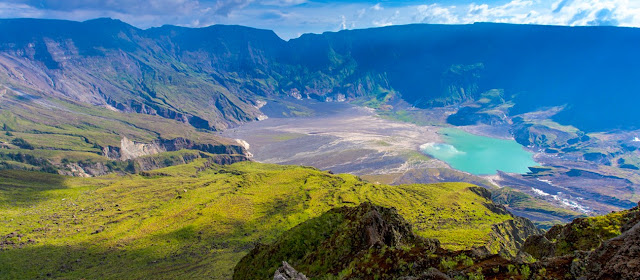On 12 April 1815, exactly 202 years ago, the Tambora volcano on the remote island of Sumbawa literally blew its top with such power that thick clouds of ash were carried around the world, to such extent that Europe experienced a year without summer. On the island of Sumbawa itself a sultanate came to its tragic end completely buried in layers of ash. Preserved remains of people and houses were later found in much the same condition as found in Pompeii. Today, scientists recognize Tambora’s eruption as the most powerful in recorded history.
To commemorate this dramatic event, Sumbawa will this year again stage “Tambora Greets the World” on 12th – 18th April 2017, to be centered at the Pekat sub-district, Dompu Regency, West Nusa Tenggara Province. Since its first edition in 2015, Tambora Greets the world has been set to become an annual international scaled event.
This year the event will be highlighted with a wide range of activities, held in all regencies across Sumbawa Island that involve art and cultural performances featuring traditional art groups in Tambora, The Offerings to the Sea ritual held along the Samota (Satonda, Moyo, and Tambora) coasts, a Cultural Parade, a cultural Jamboree at the Pancasila Village, the closest village to the Tambora Hiking Trail, and plenty more.
Situated near the northern edge of the island of Sumbawa in the West Nusa Tenggara Province, (Sumbawa is located between the islands of Lombok and Flores), Mount Tambora is known to the world as the site where the largest and most deadly volcanic eruption in recorded history occurred. Like the prehistoric Mount Toba in North Sumatra, Mount Tambora is also one of the world’s super-volcanoes. However, if the mega-eruption of Mount Toba – that occurred in the geological past- left its traces in the massive Lake Toba, Mount Tambora, on the contrary, is still very active, as it stands today at a height of 2,751 meters.
If the mega-eruption of Mount Toba is believed to have plunged the earth into a 6-to-10-years of volcanic winter, and the explosion of Mount Krakatau in 1883 produced the loudest sound ever heard in the world in modern history, the super volcanic eruption of Mount Tambora also created a global disaster when, following its eruption the previous year, the year 1816 was forever remembered in Europe and America as “The Year Without Summer", resulting in the worst famine of the 19th century.
Its catastrophic eruption in April 1815 left an impressive 7 Km wide by 6.2 km gaping caldera containing a two-colored lake with depths reaching 800 meters. It is also considered the largest caldera in Indonesia.
In 2004, archaeologist Haraldur Sigurdsson discovered the preserved bodies of two adults buried in nearly 10 feet of ash in the remnants of a small village on the slopes of the volcano. The discovery is similar to the one made in the wake of the eruption of Mount Vesuvius in Italy in the year 79 that destroyed the city of Pompeii, prompting Mount Tambora's nickname to become "the Pompeii of the East."
“The success of the initial Tambora Greets the World event became the milestone for the local authorities of Dompu, Bima, Sumbawa, and West Nusa Tenggara Province to further develop and promote its tourism splendors carrying this central theme,” said the Deputy of National Market Development of the Ministry of Tourism, Esthy Reko Astuti. Adding that next to Mount Tambora, the island of Sumbawa has, in fact, a lot of other fascinating attractions, such as Satonda Island, the fresh water spring on the beach, and the beautiful Moyo Island – the secluded island where Princess Diana found refuge when chased by paparazzi.
Head of the Office of Tourism of West Nusa Tenggara Province, Lalu Faozal said that the event is targeted to attract at least 15,000 of both domestic and international tourists.
There are regular flights by Wings Air and Garuda from Jakarta and Bali to Bima Airport in Sumbawa, the closest city to Mt. Tambora. (Indonesia.Travel)









No comments:
Post a Comment
your comments are now being moderated